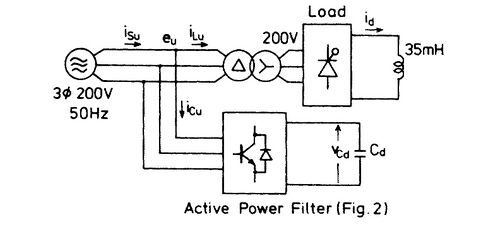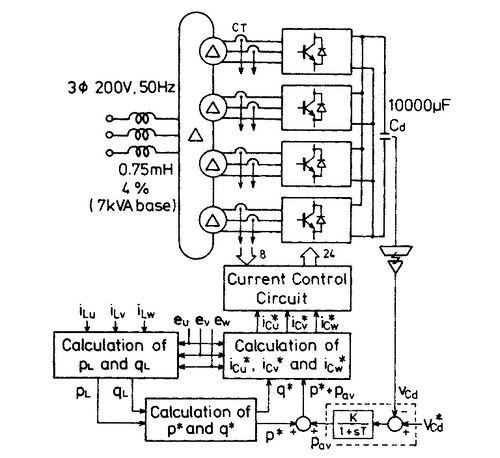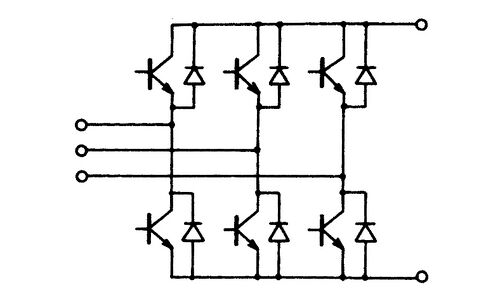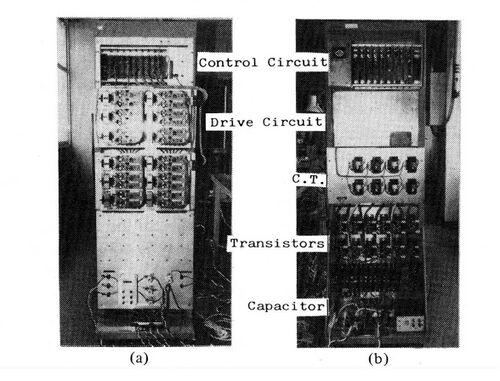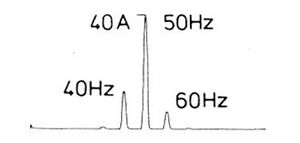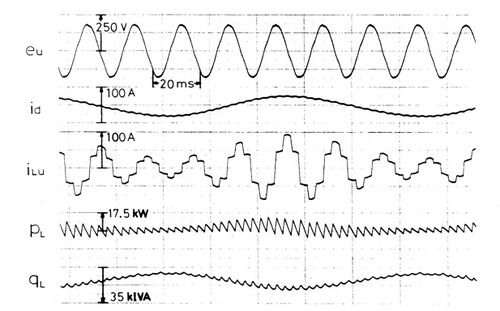Milestone-Proposal:Active Harmonic Filters, 1986
To see comments, or add a comment to this discussion, click here.
Docket #:2025-16
This is a draft proposal, that has not yet been submitted. To submit this proposal, click on the edit button in toolbar above, indicated by an icon displaying a pencil on paper. At the bottom of the form, check the box that says "Submit this proposal to the IEEE History Committee for review. Only check this when the proposal is finished" and save the page.
To the proposer’s knowledge, is this achievement subject to litigation? No
Is the achievement you are proposing more than 25 years old? Yes
Is the achievement you are proposing within IEEE’s designated fields as defined by IEEE Bylaw I-104.11, namely: Engineering, Computer Sciences and Information Technology, Physical Sciences, Biological and Medical Sciences, Mathematics, Technical Communications, Education, Management, and Law and Policy. Yes
Did the achievement provide a meaningful benefit for humanity? Yes
Was it of at least regional importance? Yes
Has an IEEE Organizational Unit agreed to pay for the milestone plaque(s)? Yes
Has the IEEE Section(s) in which the plaque(s) will be located agreed to arrange the dedication ceremony? Yes
Has the IEEE Section in which the milestone is located agreed to take responsibility for the plaque after it is dedicated? Yes
Has the owner of the site agreed to have it designated as an IEEE Milestone? Yes
Year or range of years in which the achievement occurred:
1986
Title of the proposed milestone:
Active Power Filters based on Instantaneous Powers Theory, 1986
Plaque citation summarizing the achievement and its significance; if personal name(s) are included, such name(s) must follow the achievement itself in the citation wording: Text absolutely limited by plaque dimensions to 70 words; 60 is preferable for aesthetic reasons.
Active power filters, using instantaneous-powers theory, transformed the control and design of three-phase grid-tied electronic systems in 1986. The theory introduced by Hirofumi Akagi in 1984 brought real-time compensation under dynamic, non-sinusoidal conditions to the electronic systems for power conditioning. It laid the foundation of active harmonic filters, voltage regulation devices, and smart grids, enhancing energy efficiency, grid stability, and renewable integration while shaping power electronics and electrical engineering worldwide.
200-250 word abstract describing the significance of the technical achievement being proposed, the person(s) involved, historical context, humanitarian and social impact, as well as any possible controversies the advocate might need to review.
Active power consumes electric power in alternating-current circuits, whereas reactive power does not. University professors in the department of electrical and electronic engineering around the world taught students a pair of active and reactive powers in single-phase circuits under the assumptions of sinusoidal voltage and current waveforms in steady-state conditions, and then expanded it to three-phase circuits. All the existing theories of the instantaneous reactive power based on single-phase circuits, required information on past voltage and current. This automatically rendered it inaccurate because the use of information in the past resulted in being no longer “instantaneous.” In the 1970s, power electronic experts around the world challenged to solve this problem, but no one succeeded in establishing any convincing theory.
Hirofumi Akagi, thinking in reverse, began to define a pair of instantaneous powers in three-phase circuits, and gave a mathematical proof of their physical meanings in May 1986. Both definition and physical meaning were consistent with speculation, which prompted experts to accept it as valid. Currently, Akagi’s theory is often called the “p-q theory,” amongst the experts in the world because it is characterized by a clear and unique definition of a pair of instantaneous powers, p and q, in three-phase systems. As soon as Dr. Akagi established the p-q theory, he applied it to the control and design of a reactive-power compensator consisting of semiconductor switching devices without any bulky energy storage component such as inductors or capacitors. He verified innovative operating characteristics that had until then been impossible to obtain through the application of the conventional reactive-power theory in single-phase circuits. He presented the world's first paper on the p-q theory at an international conference held in Tokyo in April 1983, followed by an IEEE Transactions paper published in May 1984 after a strict paper review process. Since then, the p-q theory has been considered as a fundamental theory in three-phase circuits, even in electrical and electronic engineering. The total citations of the conference paper in 1983 and the IEEE Transactions paper in 1984 reached more than 63,00 times, increasing over 37 years after the two papers were first presented and published.
The Instantaneous Powers Theory, also known as the “p-q Theory,” proposed by Hirofumi Akagi in the mid-1980s, represents a landmark advancement in electrical engineering. Unlike conventional power theory which started with single-phase systems, and expanding it into three-phase circuits that relied on steady-state and sinusoidal assumptions, Akagi’s theory enabled the definition and control of power flow using instantaneous voltage and current in three-phase systems. This innovation allowed real-time analysis of dynamic, distorted, and unbalanced conditions, addressing rising power quality issues caused by nonlinear loads and power electronic devices.
The theory’s practical implementation includes the control and design of active filters, and static compensators for power conditioning, and Flexible AC Transmission Systems (FACTS) for improving system stability and energy efficiency in power grid operations. It became fundamental to smart grid technologies and the integration of renewable energy sources. Furthermore, the p-q Theory’s mathematical elegance and practical applicability influenced countless academic studies, technical standards, and educational curricula worldwide.
The historical impact of the theory was immediate and far-reaching. Recognized internationally through its 1984 publication in an IEEE journal, the theory prompted new lines of research and innovation in power electronics. Decades later, it remains a cornerstone of modern power system control. Its contributions continue to shape sustainable energy systems and inspire technological advancement, making it a worthy candidate for IEEE Milestone recognition.
IEEE technical societies and technical councils within whose fields of interest the Milestone proposal resides.
IEEE Power Electronics Society
In what IEEE section(s) does it reside?
IEEE Shinetsu Section
IEEE Organizational Unit(s) which have agreed to sponsor the Milestone:
IEEE Organizational Unit(s) paying for milestone plaque(s):
Unit: IEEE Shinetsu Section
Senior Officer Name: Hiroki Yamada
IEEE Organizational Unit(s) arranging the dedication ceremony:
Unit: IEEE Shinetsu Section
Senior Officer Name: Hiroki Yamada
IEEE section(s) monitoring the plaque(s):
IEEE Section: IEEE Shinetsu Section
IEEE Section Chair name: Hiroki Yamada
Milestone proposer(s):
Proposer name: Chiaki Ishikawa
Proposer email: Proposer's email masked to public
Proposer name: Nobuko Abe
Proposer email: Proposer's email masked to public
Please note: your email address and contact information will be masked on the website for privacy reasons. Only IEEE History Center Staff will be able to view the email address.
Street address(es) and GPS coordinates in decimal form of the intended milestone plaque site(s):
長岡技術科学大学の住所を書いて下さい。 設置場所の建物名(何号館とか)も書いて下さい。 GPS座標は、上記が判れば、Google MAPで調べます。
Describe briefly the intended site(s) of the milestone plaque(s). The intended site(s) must have a direct connection with the achievement (e.g. where developed, invented, tested, demonstrated, installed, or operated, etc.). A museum where a device or example of the technology is displayed, or the university where the inventor studied, are not, in themselves, sufficient connection for a milestone plaque.
Please give the details of the mounting, i.e. on the outside of the building, in the ground floor entrance hall, on a plinth on the grounds, etc. If visitors to the plaque site will need to go through security, or make an appointment, please give the contact information visitors will need. 長岡技術科学大学の何号館のロビー?
Are the original buildings extant?
Noかな?
Details of the plaque mounting:
長岡技術科学大学の何号館のロビーに台を置いて設置を検討している?
How is the site protected/secured, and in what ways is it accessible to the public?
長岡技術科学大学の何号館のロビーは、一般の人でも許可なく立ち入ることが出来る。
Who is the present owner of the site(s)?
設置許可をくれた人の名前。
What is the historical significance of the work (its technological, scientific, or social importance)? If personal names are included in citation, include detailed support at the end of this section preceded by "Justification for Inclusion of Name(s)". (see section 6 of Milestone Guidelines)
Justification for Name-in-Citation: Professor Hirofumi Akagi
This statement is submitted to support the inclusion of Professor Hirofumi Akagi’s name in the citation of the proposed IEEE Milestone recognizing the development of the Instantaneous Reactive Power Theory, widely known as the “p-q Theory.” Developed and published by Professor Akagi in 1983–1984, this seminal theory transformed both the theoretical and practical understanding of power flow in three-phase electrical systems and has become a foundational element in the field of power electronics.
Originality and Theoretical Innovation
Professor Akagi is the sole originator of the p-q Theory, which introduced a time-domain framework for analyzing instantaneous active and reactive power in three-phase systems. At a time when traditional theories—developed by Steinmetz, Budeanu, and Fryze—were limited to sinusoidal and steady-state conditions, Akagi’s work presented a paradigm shift. By defining power quantities using instantaneous voltage and current vectors, the theory enabled accurate analysis and compensation under non-linear, non-stationary, and unbalanced conditions—scenarios increasingly common with the rise of power electronics.
Academic Impact and Global Reach
The original paper, published in IEEE Transactions on Industry Applications in 1984, has become one of the most cited references in the field of power engineering, with over 5,000 citations according to Google Scholar. The p-q Theory is now a standard analytical tool in both academic research and engineering practice, and is widely taught in graduate-level electrical engineering programs around the world. It continues to inform ongoing research in areas such as multi-phase systems, digital control, renewable energy integration, and advanced signal processing for power applications.
Industrial and Societal Applications
The practical impact of Professor Akagi’s theory is equally significant. It provided the theoretical foundation for technologies such as active harmonic filters, static compensators, custom power devices, and flexible AC transmission systems (FACTS). These systems have been deployed across power utilities, industrial plants, transportation networks (including the Shinkansen high-speed rail system), and mission-critical facilities such as data centers. His work has directly contributed to improving power quality, reducing harmonic distortion, and increasing energy efficiency and grid stability.
Recognition and Professional Leadership
Professor Akagi is globally recognized as a pioneer in power electronics. His major awards include:
- IEEE Fellow (1996), IEEE Life Fellow (2004)
- IEEE William E. Newell Power Electronics Award (2001) [A1]
- IEEE Richard H. Kaufmann Technical Field Award (2008) [A3]
- IEEE Medal in Power Engineering (2018) [A4]
- Medal with Purple Ribbon, Government of Japan(年度?) [A6]
Election to the U.S. National Academy of Engineering (2025) for “contributions to the theory, design, and application of utility high-power electronic systems” [A5].
He has served as President of the IEEE Power Electronics Society(任期?), Director of IEEE Division II(任期?), and Editor-in-Chief of IEEE Transactions on Power Electronics(任期?). He is a highly sought-after keynote speaker at major international conferences, including ECCE, EPE, and PEDS, and has mentored numerous students and researchers who continue to advance his work.
Individual Achievement and Legacy
Unlike many modern technologies that emerge from large research teams or industry-academia collaborations, the p-q Theory is a product of Professor Akagi’s independent insight and rigorous scholarship. His original publication laid out a complete and enduring theoretical framework that has required minimal revision over four decades—a rare achievement in engineering science.
The inclusion of Professor Hirofumi Akagi’s name in the citation of this IEEE Milestone is therefore not only appropriate but essential. His original and lasting contribution to the field of power electronics continues to influence how electric power is understood, controlled, and applied in a modern, sustainable society. His legacy stands as a singular achievement in the history of electrical engineering.
Historical Significance
Overview of the Instantaneous Reactive Power Theory and Its Invention
In the mid-1980s, Professor Hirofumi Akagi of Nagaoka University of Technology proposed a groundbreaking theory known as the Instantaneous Reactive Power Theory (commonly referred to as the p-q Theory). This theory fundamentally changed the way electric power is understood and controlled in three-phase power systems.
Conventional reactive power theories relied on the averaging of voltage and current over time, assuming steady-state and sinusoidal conditions. These approaches were based primarily on single-phase systems and were inadequate in addressing the transient and unbalanced conditions increasingly seen with the spread of power electronic devices. In contrast, Akagi's theory introduced a novel approach: defining reactive power based on the instantaneous values of voltages and currents in a three-phase system. This enabled real-time analysis and control of power flow, even in the presence of non-sinusoidal and unbalanced loads.
Applications: Three-Phase Power Conversion and Control Systems
Professor Akagi's theory was not just of academic interest—it was directly applicable to real-world control and design of power electronic systems. Specifically, it became the foundation for real-time compensation of reactive power and power quality improvement in three-phase systems using inverters and converters.
The theory was implemented in control and design of active harmonic filters, static synchronous compensators (STATCOMs), and other Flexible AC Transmission Systems (FACTS) devices. These applications contributed to the stability and efficiency of electric power grids and found widespread use in industrial power supplies, railways, and distributed generation systems. The practical applicability and versatility of the theory led to numerous commercial and industrial deployments worldwide.
Active Power Filter System
・・・この節は、もう少ししっかり書くこと
Basic Compensation Principle
Fig. 1 shows a basic compensation principle of active power filters. The compensation objectives of active power filters are the harmonics present in the input currents iLu, iLv, and iLw of the load. Since the compensating currents iCut iCv, and iCw are controlled so as to eliminate the harmonic currents of the load,
the source currents is,, is, and is,, become sinusoidal.
Figure 1 A basic compensation principle of active power filters
Power Circuit Configuration
Fig. 2 shows the active power filter system (leveloped in this paper. The quadruple voltage-source PWM converters are adopted as the power circuit. Note that the primary windings
of the four three-phase transformers are connected to each other in series. So, the primary voltage of each transformer is 50 V and the secondary is 100 V. The primary windings of the
four transformers can be connected to each other in parallel if the transformers of primary voltage (200 V) and secondary voltage (100 V) are applied. The multiple converters in
parallel, however, are less efficient than those in series because of the increase of harmonic currents in each secondary winding and converter.
The converter is a conventional three-phase bridge converter consisting of six power transistors and six power diodes connected back-to-back, as shown in Fig. 3. The turn-off time of the power transistors was about 15 ,us and nearly equal to that of large capacity GTO thyristors.
Figure 2 Diagram of Active Power Filter
Figure 3 Circuit of active power filter.
The experimental compensation system
The experimental compensation system is shown in Fig. 2. The load is a three-phase thyristor bridge converter of rating 20 kVA. Fig. 7 shows the experimental active power filter of rating 7 kVA.
Figure 4 Photograph of experimental active power filter. (a) Front. (b)Back.
Experimental Results: Waveforms of pL and qL
The experimental compensation system is shown in Fig. 1.
The load is a three-phase thyristor bridge converter of rating 20 kVA. Fig. 7 shows the experimental active power filter of rating 7 kVA. To discuss the compensation characteristics in the transient states, the firing angle of the thyristor bridge converter is controlled so as to generate the following dc output current:
式と記号の意味が判らない。Figure 1を説明も要
id = Id + Ido ・sin 2π・fo・ t. (1)
Then the harmonic frequencies Jh present in the input current are given by
fh =ft± n・fo (6m ± l)・fi± n・fo (2)
where fi is the line (input) frequency, m = 1, 2, 3, * * *, and n= 0, 1, 2, .... Fig. 5 shows the experimental frequency spectrum around the line frequency under the following condition: line voltage (rms) = 200 V, f, = 50 Hz, fo = 10Hz, Id = 50 A, Ido = 30 A. The reason why fo was chosen as 10 Hz is that the frequency of the "flicker" caused by arc furnaces is about 10 Hz.
The experimental waveforms shown in Fig. 6 are the u-phase voltage e", the dc output current id, the u-phase input current of the thyristor bridge converter, i.e., the u-phase load current iLu, and the instantaneous real and imaginary powers pL and qL under the same condition. The sub-harmonic current of 40 Hz and the super-harmonic current of 60 Hz are caused by the component of 10 Hz present in pL and qL. The amplitude of the sub- and super-harmonic currents depends on the amplitude and phase of the component of 10 Hz in fL and qL .
Figure 5 Experimental frequency spectrum
Figure 6 Experimental waveforms
Historical Significance
A Breakthrough in Electric Power Theory
The Instantaneous Reactive Power Theory (commonly known as the pq theory), proposed in 1983 by Professor Hirofumi Akagi and his collaborators, represents a groundbreaking advancement in the field of power electronics and electric energy systems. For the first time, this theory provided a mathematically rigorous and physically meaningful way to define and control active and reactive power in three-phase circuits under non-sinusoidal and unbalanced conditions, in real time.
Overcoming Limitations of Classical Power Concepts
Prior to the pq theory, reactive power concepts were fundamentally limited to steady-state sinusoidal conditions, making them inadequate for the growing number of nonlinear and time-varying electrical systems. The pq theory overcame this limitation by introducing a coordinate transformation framework that enabled the real-time decomposition of instantaneous power into meaningful components. This provided the theoretical foundation for a new class of power control technologies, particularly active power filters, power conditioners, and grid-interfacing converters.
Widespread Academic and Industrial Adoption
The pq theory has had a profound and lasting impact on both academia and industry. It has become a core principle taught in graduate-level power electronics curricula worldwide and has inspired hundreds of research papers and industrial applications. The theory has played a central role in the development of high-performance power quality solutions, smart grids, renewable energy interfaces, electric vehicle powertrains, and energy-efficient industrial drives.
Improving Power Quality and Enabling Sustainable Systems
By enabling precise, real-time compensation of harmonic currents, unbalanced loads, and reactive power, the pq theory significantly improved the reliability, efficiency, and power quality of modern electrical systems. Its influence is global, with applications deployed in utilities, manufacturing plants, transportation systems, and data centers. In particular, the theory has been implemented in a wide range of active power filters and PWM inverter control schemes, forming the basis of energy management systems across industrial and public infrastructures.
In Japan, the pq theory has been incorporated into railway traction systems, including those used in Shinkansen high-speed trains, where it contributes to efficient regenerative braking and minimization of harmonic interference with the power grid. It is also used in factory automation systems, semiconductor fabrication plants, and HVAC power controllers in large buildings, where maintaining stable and clean power is critical to productivity and equipment lifespan. Moreover, in electric vehicle (EV) charging stations, wind turbines, and photovoltaic systems, the pq theory enables seamless integration with the grid by compensating for dynamic power fluctuations and improving the stability of renewable energy sources.
The theory is also integral to the operation of modern FACTS (Flexible AC Transmission Systems) and microgrids, making it indispensable in the transition to sustainable and intelligent energy networks.
A Lasting Legacy in Electric Power Engineering
The pq theory thus marks a paradigm shift in electric power engineering, bridging classical reactive power concepts with modern digital control and real-time signal processing. Its enduring relevance more than four decades after its publication attests to its foundational importance in the evolution of power systems engineering.
What obstacles (technical, political, geographic) needed to be overcome?
Challenges and Solutions
Technical Challenges
During the 1980s, global industry faced a rise in power quality issues due to the proliferation of nonlinear loads and power electronic devices. Harmonic distortion, voltage fluctuations, and unbalanced loads became increasingly problematic, causing instability in power systems.
Conventional reactive power theories, designed for steady-state sinusoidal conditions, could not address these new dynamic phenomena. Akagi’s theory provided a solution by enabling real-time computation and control of power flow using instantaneous values—meeting the demands of evolving electrical networks.
Political Challenges
Japan, like many industrialized nations during the 1980s, was undergoing a transformation toward high-efficiency manufacturing and energy-savings technologies. Stable and efficient power systems were a national priority, and energy policies strongly supported innovation in this field.
Akagi’s theory emerged as a timely response to these political and societal needs. It offered a theoretical foundation for controlling and optimizing power systems under the pressures of growing demand and increasing complexity, and it aligned well with policy goals regarding energy security and sustainability.
Geographical Challenges
Japan’s geography—with long, narrow islands and dispersed power generation and consumption centers—posed unique challenges for power transmission and distribution. Reactive power compensation over long distances was difficult using traditional methods.
The instantaneous reactive power theory allowed for localized and dynamic power control, overcoming geographical constraints. This enabled more efficient and reliable power delivery across distributed systems and made it easier to integrate renewable energy and distributed generation.
What features set this work apart from similar achievements?
What features set this work apart from similar achievements?
Characteristics of the Instantaneous-Powers Theory
The Instantaneous Reactive Power Theory, developed by Professor Hirofumi Akagi in the mid-1980s, stands apart from similar achievements in power system engineering due to its conceptual originality, broad applicability, and long-lasting global impact.
Most notably, this theory introduced a paradigm shift by defining reactive power in the time domain using instantaneous voltage and current in three-phase circuits. At the time, existing theories of reactive power—based on sinusoidal steady-state assumptions and root-mean-square values—were fundamentally limited. They could not describe power flow accurately under non-sinusoidal or unbalanced conditions, which had become increasingly common due to the proliferation of power electronic equipment and nonlinear loads.
Akagi’s theory overcame these limitations by providing a mathematically rigorous and physically meaningful framework for real-time power analysis. This enabled the dynamic control of active and reactive power, even in highly distorted and transient environments, which was unachievable with prior approaches. The resulting p-q Theory became the foundation for modern power conditioning technologies such as active power filters and static compensators, and was directly applicable to the control of voltage, harmonics, and reactive currents.
What further distinguishes this work is its wide-ranging impact across both academic and industrial sectors. Since its first publication in 1984 in an IEEE journal, the theory has been cited extensively and adopted internationally. It has influenced technical standards, informed power engineering education worldwide, and led to the practical implementation of advanced control systems in utility grids, transportation networks, and renewable energy integration.
Unlike other theories developed around the same time—which often addressed narrow technical problems—the p-q Theory provided a unified and scalable solution to the broader challenge of power quality and system stability. It also proved to be flexible: adaptable to different system configurations, including single-phase, three-phase, and multi-phase systems, and expandable through later research that incorporated energy storage, digital signal processing, and smart grid applications.
Finally, the theory’s robustness and durability are exceptional. More than 40 years after its inception, it remains relevant and continues to support innovations in next-generation electrical infrastructure. Its enduring influence, combined with its foundational role in both theoretical advancement and real-world engineering, makes it a singular achievement in the history of electrical power systems.
Comparison with Other Methods
Professor Akagi’s theory marked a significant departure from conventional reactive power concepts, particularly those developed by Steinmetz and others in the early to mid-20th century. While traditional theories relied on steady-state analysis and assumed sinusoidal waveforms, the p-q theory was formulated in the time domain, using instantaneous voltage and current vectors to define active and reactive power.
This fundamental shift enabled the analysis and control of power flow in transient, unbalanced, and distorted conditions—something that traditional methods could not achieve. Moreover, while conventional theories lacked a clear strategy for non-linear and non-stationary systems, Akagi’s theory provided a practical framework for real-time control in such environments.
Unlike earlier approaches, the p-q theory supported a wide range of applications, including harmonic compensation, voltage regulation, and active filtering. It also proved essential in modern developments such as smart grids and renewable energy systems, demonstrating its flexibility and scalability. Its real-time capabilities and mathematical rigor made it not only a technological advancement but also a scientific milestone in electrical engineering.
Why was the achievement successful and impactful?
Why the achievement was successful and impactful?
The achievement of active harmonic filters, based on Hirofumi Akagi's instantaneous power theory (p-q theory), was both successful and impactful for several reasons:
Theoretical Innovation and Practical Application
In 1986, Akagi introduced the p-q theory, a novel approach to analyzing and compensating harmonic and reactive power in three-phase systems. Unlike previous theories that relied on past voltage and current information, the p-q theory utilized real-time data, enabling instantaneous compensation. This theoretical advancement laid the groundwork for the development of active harmonic filters, marking a significant departure from traditional passive filtering methods.
Industrial and Global Adoption
The practical application of Akagi's theory led to the creation of active harmonic filters that could dynamically compensate for harmonics and reactive power in real-time. These filters were successfully implemented in various industrial settings, demonstrating their effectiveness in improving power quality. The adoption of this technology extended beyond Japan, influencing global standards and practices in power electronics and electrical engineering.
Alignment with Global Standards and Environmental Goals
The introduction of active harmonic filters coincided with increasing global awareness of power quality issues and environmental concerns. By mitigating harmonics and improving power efficiency, these filters contributed to the reduction of energy losses and the enhancement of grid stability. Their implementation supported compliance with international standards such as IEEE 519 and IEC 61000, which set limits on harmonic distortion in electrical systems.
Lasting Legacy and Ongoing Impact
The principles established by Akagi's p-q theory continue to underpin modern power electronic systems, including smart grids and renewable energy integration. The ongoing research and development in active power filtering technologies attest to the enduring relevance and impact of this achievement. The widespread use of active harmonic filters has become a standard practice in the industry, reflecting their success and the lasting influence of Akagi's work.
In summary, the development and implementation of active harmonic filters based on the p-q theory were successful due to their theoretical innovation, practical applicability, alignment with global standards, and lasting impact on the field of power electronics. This achievement has significantly advanced the understanding and management of power quality issues, benefiting both industry and society at large.
Supporting texts and citations to establish the dates, location, and importance of the achievement: Minimum of five (5), but as many as needed to support the milestone, such as patents, contemporary newspaper articles, journal articles, or chapters in scholarly books. 'Scholarly' is defined as peer-reviewed, with references, and published. You must supply the texts or excerpts themselves, not just the references. At least one of the references must be from a scholarly book or journal article. All supporting materials must be in English, or accompanied by an English translation.
Referenceを整理する!本文で引用しないものは除く。本文の引用箇所にReference番号を付ける。
Bibliography
References
[1] H. Akagi, Y. Kanazawa, and A. Nabae, “Generalized theory of the instantaneous reactive power in three-phase circuits,” Proceedings of IEE of Japan International Power Electronics Conference (IPEC-Tokyo), March 1983, pp. 1375-1386. (1650 citations)
[2] H. Akagi, Y. Kanazawa, and A. Nabae, “Instantaneous reactive power compensators comprising switching devices without energy storage components,” IEEE Transactions on Industry Applications, vol. 20, no. 3, pp. 625-630, May/June, 1984. (4877 citations)
[3] H. Akagi, A. Nabae, and S. Atoh, “Control strategy of active power filters using multiple voltage-source PWM converters,” IEEE Transactions on Industry Applications, vol. 22, no. 3, pp. 460-465, May/June, 1986. (1023 citations)
[4] H. Akagi, E. H. Watanabe, and M. Aredes, “Instantaneous power theory and applications to power conditioning,” IEEE Press, 400 pages, 2007 (first edition), and 472 pages, 2017 (second edition). (3580 citations in total)
[5] H. Akagi, “New trends in active filters for power conditioning,” IEEE Transactions on Industry Applications, vol. 32, no. 6, pp. 1312-1322, Nov./Dec. 1996. (2694 citations)
[6] H. Akagi, “Active harmonic filters (invited paper),” Proceedings of the IEEE, vol. 93, no. 12, pp. 2128-2141, Dec. 2005. (1406 citations)
[7] A. Iizuka, M. Kishida, Y. Mochinaga, T. Uzuki, K. Hirakawa, F. Aoyama, and T. Masuyama, “Self-commutated static var generator at Shintakatsuka substation,” Proceedings of IEEJ International Power Electronics Conference (IPEC-Yokohama), April 1995, pp. 609-614.
[8] F. Harashima, H. Inaba, and K. Tsuboi, “A closed-loop control system for the reduction of reactive power required by electronic converters,” IEEE Transactions on Industrial Electronics and Control Instrumentation, vol. 23, no. 2, pp. 162-166, May 1976.
[9] K. Srinivasan and C. T. Nguyen, “Instantaneous three-phase reactive power for digital Implementation: Definition and determination,” Proceedings of the IEEE, vol. 66, no. 8, pp. 986-987, Aug. 1978.
[10] L. Gyugyi, “Reactive power generation and control by thyristor circuits,” IEEE Transactions on Industry Applications, vol. 15, no. 5, pp. 521-532, Spt./Oct., 1979.
[11] I. Takahashi and A. Nabae, “Universal power distortion compensator of line commutated thyristor converter,” Proceedings of IEEE Industry Applications Society Annual Meeting, Oct. 1980, pp. 858-863.
[12] S. Miyairi, H. Akagi, T. Fukao, and M. Fujita, “Equivalence in harmonics between cycloconverters and bridge converters,” IEEE Transactions on Industry Applications, vol. 15, no. 1, pp. 92-99, Jan/Feb, 1979.
[13] A. Ferrero and G. Superti-Furga, “A new approach to the definition of power components in three- phase systems under non-sinusoidal conditions,” IEEE Transactions on Instrumentation and Measurement, vol. 40, no. 3, pp. 568-577, June 1991.
[14] J. L. Willems, “A new interpretation of the Akagi-Nabae power components for non- sinusoidal three-phase situations,” IEEE Transactions on Instrumentation and Measurement, vol. 41, no. 4, pp. 523-527, Aug. 1992.
Awards
[A1] William E. Newell Power Electronics Award - IEEE Power Electronics Society
2001 Hirofumi Akagi
[A2] Outstanding Achievement Award - IEEE Industry Applications Society
2004 Hirofumi Akagi
[A3] IEEE Richard Harold Kaufmann Award - IEEE Industry Applications Society 2008 Hirofumi Akagi
[A4] 2008 IEEE Medal in Power Engineering Recipients
https://corporate-awards.ieee.org/wp-content/uploads/pwr-engrg-rl.pdf
Election citation: For pioneering contributions to theory and practice of power conversion systems and their applications.
[A5] International member of the United States National Academy of Engineering
2025 NAE Website - Dr. Hirofumi Akagi
Election citation: For contributions to the theory, design, and application of utility high-power electronic systems.
[A6} Medal with Purple Ribbon, Government of Japan.
Supporting materials (supported formats: GIF, JPEG, PNG, PDF, DOC): All supporting materials must be in English, or if not in English, accompanied by an English translation. You must supply the texts or excerpts themselves, not just the references. For documents that are copyright-encumbered, or which you do not have rights to post, email the documents themselves to ieee-history@ieee.org. Please see the Milestone Program Guidelines for more information. Please email a jpeg or PDF a letter in English, or with English translation, from the site owner(s) giving permission to place IEEE milestone plaque on the property, and a letter (or forwarded email) from the appropriate Section Chair supporting the Milestone application to ieee-history@ieee.org with the subject line "Attention: Milestone Administrator." Note that there are multiple texts of the letter depending on whether an IEEE organizational unit other than the section will be paying for the plaque(s). Please recommend reviewers by emailing their names and email addresses to ieee-history@ieee.org. Please include the docket number and brief title of your proposal in the subject line of all emails.
